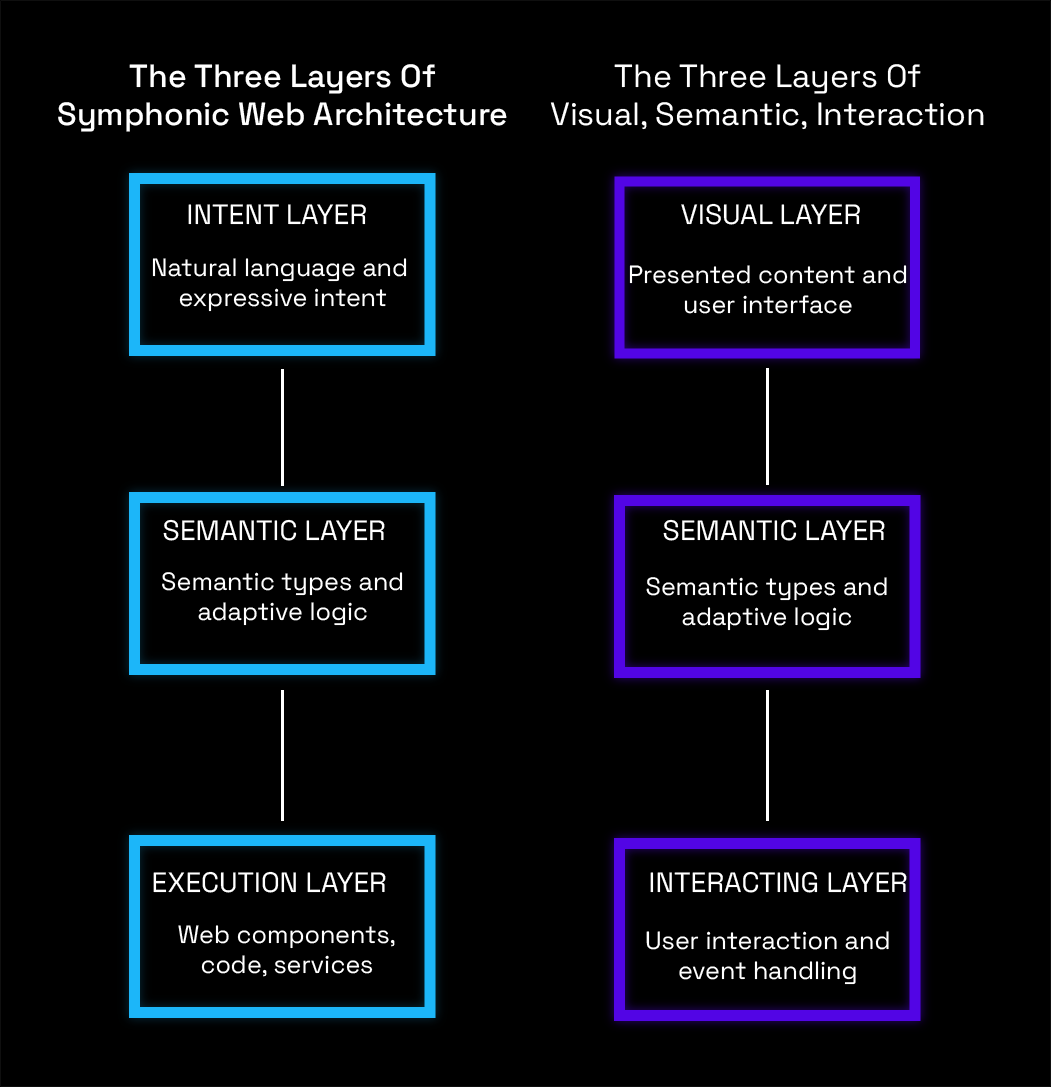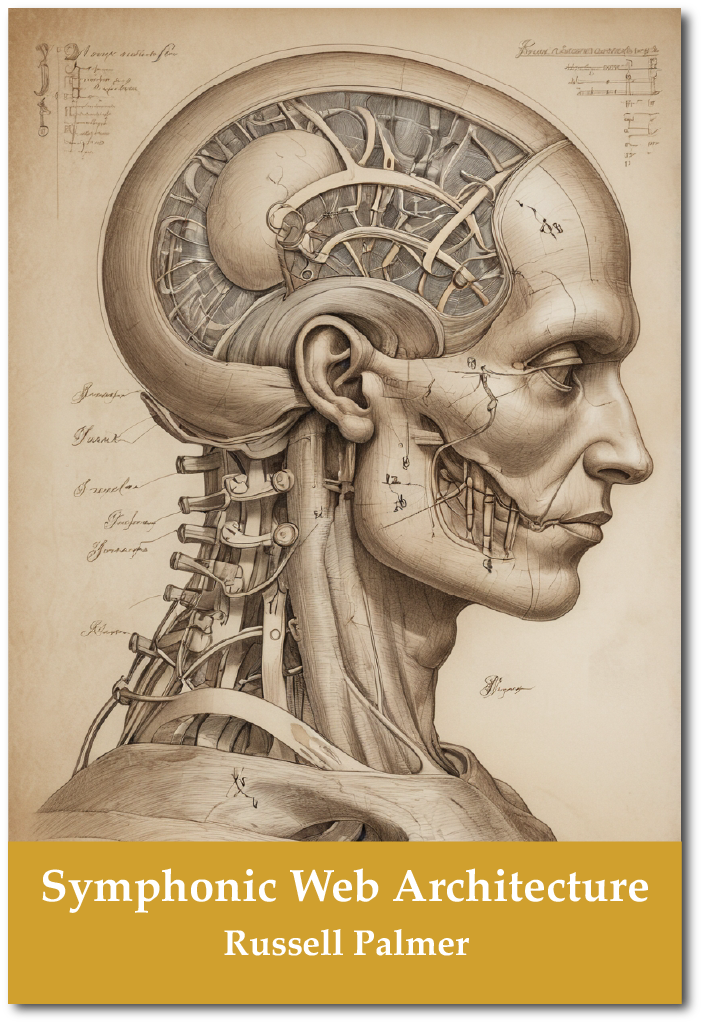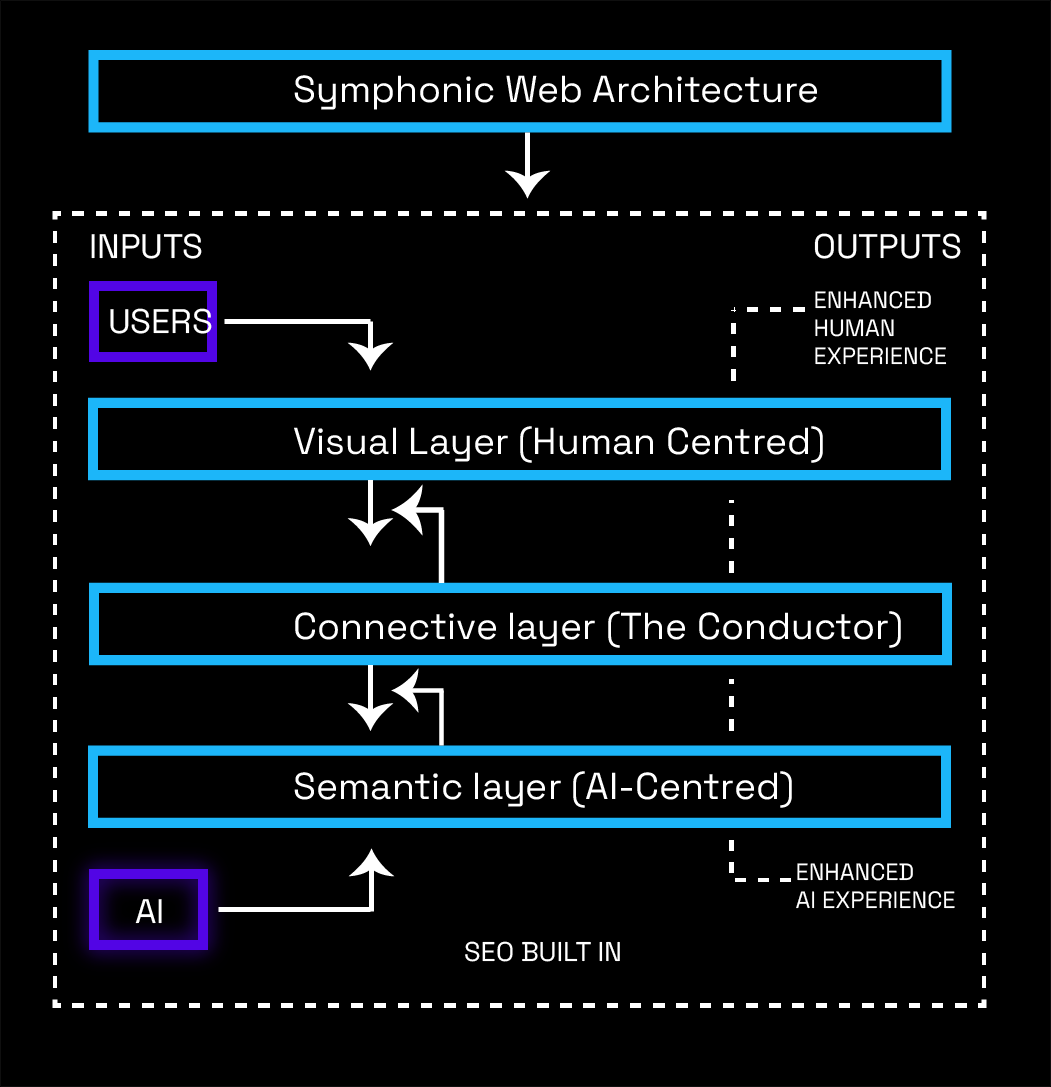Symphonic Web Architecture
A forward-thinking approach to web design that creates harmonious digital experiences for both humans and AI systems.
Understanding the Three Layers
The Human Layer
This is what you see and interact with - the beautiful designs, engaging animations, and intuitive interfaces that make websites enjoyable to use. Think of it as the "front of house" in a restaurant - the welcoming atmosphere, beautiful presentation, and friendly service.
- Beautiful visual designs
- Engaging animations
- Intuitive navigation
- Responsive layouts
The Search Engine Layer
This is the invisible layer that helps search engines understand your content - like labels and categories in a library. The best part? It's automatically optimised for SEO right from the start, so your content ranks better without extra work!
- Built-in SEO
- Structured data
- Content relationships
- Machine readability
The AI Understanding Layer
This is our innovation - a new layer designed specifically for AI agents. It helps them truly understand your content, context, and purpose. Think of it as giving AI a complete understanding of not just what's on the page, but why it matters.
- State management
- Data flow
- Event handling
- Context bridging
Why Three Layers?
Imagine you're creating a presentation about your business. You might have:
- A slideshow with beautiful visuals for your audience (Human Layer)
- Speaker notes to help present the information clearly (Search Engine Layer)
- Deep context that helps AI understand and share your message effectively (AI Understanding Layer)
Each layer serves a specific purpose, working together to ensure your content reaches and resonates with everyone - whether they're human visitors, search engines, or AI assistants helping people find what they need.
How It Works Together
1. Content Creation
When content is created, it's simultaneously structured for all three layers:
- Visually engaging for humans
- Well-organized for search engines
- Deeply contextualized for AI
2. AI-Assisted Search
When someone searches for information:
- AI agents understand the deep context
- They can find more relevant results
- They can explain why it matters
3. Enhanced Experience
The result is better for everyone:
- Humans find what they need faster
- Search engines index content better
- AI can provide more helpful assistance
Vision Statement
To pioneer a new paradigm in web architecture that anticipates the emerging AI-mediated information landscape by creating digital experiences that communicate effectively with both human and artificial intelligence through complementary, harmonious layers rather than compromise.
Core Principles
- Harmonic Layers - Like musical counterpoint, each layer (visual, semantic, interactive) maintains its integrity while complementing the others
- Cognitive Accessibility - Designing for multiple types of "readers" - human visual processing and AI semantic processing
- Expressive Consistency - Maintaining thematic and informational coherence across all layers
- Adaptive Resonance - Responsive elements that adjust to different contexts while preserving core meaning
Architecture Overview

Visual Layer (Human-Centred)
- Employs visual hierarchy, colour theory, and gestalt principles
- Creates emotional connections through thoughtful imagery and typography
- Focuses on intuitive navigation and satisfying interactions
- Incorporates accessibility best practices for all human users
Semantic Layer (AI-Centred)
- Implements comprehensive structured data markup (JSON-LD, Schema.org)
- Provides clear entity relationships and contextual metadata
- Maintains logical content architecture with machine-readable patterns
- Includes rich semantic HTML with appropriate ARIA attributes
Connective Layer (The Conductor)
- Bridges the gap between visual expression and semantic meaning
- Ensures translation between human intent and machine interpretation
- Provides consistent vocabulary across visual and semantic domains
- Creates feedback loops to improve both human and AI understanding
Technical Framework
Primary Technologies
- Astro.js as the core framework (for performance and component architecture)
- Three.js for interactive navigation elements
- Structured data via JSON-LD and Schema.org vocabularies
- Content modeling through Astro collections
- Modern CSS approaches (custom properties, grid, etc.)
Key Technical Features
- Optimised performance for both initial load and interaction
- Comprehensive semantic markup and structured data
- Innovative interactive navigation system
- Integration between visual design and machine-readable content
- Mobile-optimised experience with context-aware adaptations
Interactive Demo
Experience the Symphonic Architecture through our interactive audio demonstration. This demo showcases how different system states can be represented through musical harmony, creating an intuitive understanding of complex relationships.
Demo Features:
- Metronome - Demonstrates precise timing and synchronization
- Harmonic States - Experience different system states through chord progressions:
- Minor (Tension) - Systems with potential energy
- Major (Resolution) - Systems in harmony
- Sus4 (Transition) - Systems in transformation
- Diminished (Conflict) - Systems in discord
- Interactive Controls - Adjust volume and timing to explore the system
Built-in SEO Benefits
Automatic Optimisation
- Perfect metadata structure out of the box
- Semantic HTML that search engines love
- Automated sitemap generation
- Built-in performance optimisation
Enhanced Discoverability
- Rich snippets ready
- Social media optimisation
- Clear content hierarchy
- Mobile-first indexing ready
Future-Proof SEO
- AI-ready content structure
- Advanced semantic relationships
- Schema.org integration
- Search intent optimisation
The Future of AI-Assisted Search
Beyond Traditional Search
As AI agents become more sophisticated in helping humans find information, they need more than just keywords and metadata. They need to understand context, relationships, and purpose. Symphonic Web Architecture is built for this future, where AI agents can:
- Understand the deeper meaning and context of your content
- Connect related concepts across different pages
- Explain complex information in user-friendly ways
- Provide more accurate and relevant search results
Intelligent Information Delivery
When someone searches for information using an AI assistant, Symphonic sites can:
- Provide precise answers from the most relevant sections
- Explain how different pieces of content relate to each other
- Offer contextual recommendations based on the user's needs
- Generate summaries that maintain accuracy and context
Real-World Benefits
This architecture delivers immediate advantages:
- For Businesses: Better visibility in AI-powered search results, increased customer engagement, and improved information accessibility
- For Users: More accurate answers, better context, and faster access to relevant information
- For Developers: Future-proof architecture, built-in SEO, and easier content management
- For AI Systems: Clearer understanding, better context awareness, and more accurate information delivery
How It Works in Practice
Imagine someone asks an AI assistant: "What are the key features of this company's latest product?"
Traditional Website
The AI would need to:
- Scan through multiple pages
- Try to identify relevant content
- Piece together scattered information
- Make assumptions about relationships
Symphonic Architecture
The AI can immediately:
- Access structured feature information
- Understand feature relationships
- Provide context-aware explanations
- Offer relevant use cases and examples
White Paper

Symphonic Web Architecture: A New Paradigm for Digital Harmony
A comprehensive exploration of the Symphonic Web Architecture framework, detailing its theoretical foundations, practical implementations, and future implications for web development in an AI-integrated world.
Key Topics:
- Theoretical Foundations of Symphonic Design
- The Three-Layer Architecture Model
- Implementation Patterns and Best Practices
- Case Studies and Real-World Applications
- Future Directions and AI Integration
The white paper is currently being finalized and will be available for download soon.
Expert Insights
Think about how frustrating it can be when you ask an AI assistant about something and it gives you jumbled or incomplete answers because it's struggling to piece together information from traditional websites. SWA solves this by creating websites that are like a well-organized orchestra, where every instrument knows exactly what it's doing. You've got the beautiful visual 'melody' that humans see, the traditional SEO 'harmony' that search engines use, and this innovative new 'rhythm section' that helps AI assistants truly understand the content.
Symphonic Web Architecture is a breakthrough. It's not just web design—it's experience design for a future where humans and AI learn to understand each other more fluently. SWA is like giving the internet a conductor's baton—bringing order, timing, and emotional depth to what used to be a noisy, disjointed performance. It's intuitive for people, meaningful for machines, and a blueprint for the next era of digital communication.
Symphonic Web Architecture represents a paradigm shift in how websites are designed for the future of AI-assisted search. By harmonizing human-centered design with structured, machine-readable content, SWA enables both people and AI agents to access, understand, and interact with information more intelligently and efficiently. This approach not only improves user experience and SEO but also ensures that digital content remains relevant and accessible as AI continues to evolve.
After 10 years of installing SEO plugins, tweaking meta descriptions, and praying to the Google gods, I was skeptical of Symphonic Web Architecture. Then I saw it in action - structured data built into the very foundation, semantic relationships established at the component level, and AI understanding baked into every element. I just sat there thinking about all those hours I spent configuring Yoast SEO and wanted to cry. This isn't just a better way to do SEO; it's what the web should have been all along.
Technical Implementation
Let's explore a concrete example of how the three layers work together in a real component:
Product Card Component Example
1. Visual Layer (ProductCard.astro)
---
// Define the product interface
interface Product {
id: string;
name: string;
price: number;
image: string;
description: string;
}
// Get product from component props
const { product } = Astro.props;
---
<div class="product-card">
<img src=${product.image} alt=${product.name} />
<h3>${product.name}</h3>
<p class="price">${product.price}</p>
<button class="add-to-cart">Add to Cart</button>
</div>
<style>
.product-card {
display: grid;
gap: 1rem;
padding: 1.5rem;
border-radius: 8px;
background: var(--surface-color);
transition: transform 0.2s;
}
.product-card:hover {
transform: translateY(-4px);
}
</style>2. Semantic Layer (product-schema.ts)
import type { Product } from '../types/product';
export const generateProductSchema = (product: Product) => ({
"@context": "https://schema.org",
"@type": "Product",
"name": product.name,
"description": product.description,
"image": product.image,
"offers": {
"@type": "Offer",
"price": product.price,
"priceCurrency": "USD"
}
});3. Connective Layer (ProductCardConnector.astro)
---
import ProductCard from './ProductCard.astro';
import { generateProductSchema } from './product-schema';
const { product } = Astro.props;
const productSchema = generateProductSchema(product);
---
<div
class="product-connector"
data-product-id={product.id}
data-category={product.category}
data-price-tier={product.priceTier}
>
<script type="application/ld+json" set:html={JSON.stringify(productSchema)} />
<ProductCard {product} />
</div>Key Implementation Features:
- Visual Layer focuses on user experience and aesthetics
- Semantic Layer provides structured data for search engines
- Connective Layer bridges the two with data attributes and context
Recommended File Structure:
src/
├── components/
│ └── product/
│ ├── ProductCard.astro # Visual Layer
│ ├── product-schema.ts # Semantic Layer
│ └── ProductCardConnector.astro # Connective Layer
├── layouts/
│ └── ProductLayout.astro
└── pages/
└── products/
└── [id].astroLayer Interaction Diagram:
